
Page 2 of 4
Don't Underestimate the Importance of LEL Correlation Factors
Four of your team members are hard at work, side by side at your facility. Each is wearing a brand-new gas detector that was calibrated and bump tested only a few hours ago. The problem is that two of the instruments are in high alarm, one is in low alarm, and the fourth is not in alarm at all. Which instrument is defective? The two instruments in high alarm? The one instrument in low alarm? How about the instrument not in alarm at all? Are they all broken? Actually, the instruments may all be working perfectly.…
Many members of the safety community have spent a lot of time recently debating which Lower Explosive Limit (LEL) sensor technology is superior--the industry-standard catalytic bead (CB) technology, which has been in use for more than 50 years, or the newer infrared (IR) sensor technology. Much has been written about the strengths and weakness of each technology and can easily be found by your favorite search engine. This article will discuss the intersection of correlation factors, calibration gas, LEL sensor technologies, and their impact on ensuring every worker returns home at the end of his shift.
Let's start with a quick summary of the sensor technologies. Both CB and IR sensors are designed to protect against the combustion of gases in the atmosphere, not the detection of one combustible gas specifically. In other words, LEL sensors do not know whether it is detecting pentane, methane, or propane, but it only recognizes that one or more combustible gases are in the atmosphere. For this reason, both CB and IR sensors must be characterized through calibration. The McGraw-Hill Science and Technology Encyclopedia defines calibration as "the process of determining the performance parameters of an instrument by comparing it with measurement standards."
Once calibrated with a particular gas, the instrument will display LEL values assuming all gases in the environment are that one specific gas. If a sensor calibrated to methane detects ethane, the instrument will display LEL values assuming it is truly methane. Many members of the safety community understand this challenge and have procedures in place to account for this sensor limitation. (Please note that this article refers to LEL IR sensors, not gas-specific sensors like methane IR. LEL IR sensors are sometimes called Hydrocarbon IR sensors.)
Correlation factors are used to translate instrument readings from the units of the calibration gas to the units of a second desired gas. For example, correlation factors can be used to translate readings on a pentane-calibrated instrument to equivalent units of ethane.
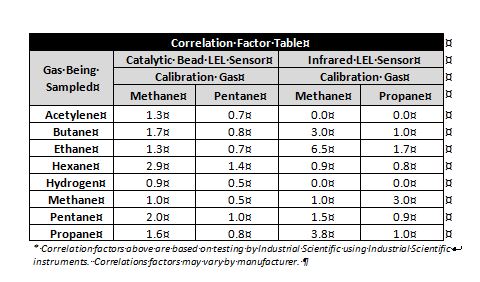 The next challenge is that most members of the safety community were trained on the industry-standard CB LEL sensor technology. This training leads to typical alarm levels of 10 percent LEL and 20 percent LEL because most CB correlations factors are relatively close to the reading on the display, typically two times or less. The logic is the combustible gases in the atmosphere will not exceed 40 percent LEL (20 percent LEL high alarm multiplied by a correlation factor of 2), assuming a worst-case scenario. Even assuming a +25 percent error in the reading, the user is still below the lower explosive limit and has time to retreat to a safe location.
The next challenge is that most members of the safety community were trained on the industry-standard CB LEL sensor technology. This training leads to typical alarm levels of 10 percent LEL and 20 percent LEL because most CB correlations factors are relatively close to the reading on the display, typically two times or less. The logic is the combustible gases in the atmosphere will not exceed 40 percent LEL (20 percent LEL high alarm multiplied by a correlation factor of 2), assuming a worst-case scenario. Even assuming a +25 percent error in the reading, the user is still below the lower explosive limit and has time to retreat to a safe location.
With the continuing emergence of IR technology, many users assume the sensor performs in the same way as catalytic bead technology, even though the detection technology is very different. Not only is that assumption incorrect, but also it can be very dangerous. Calibrating CB and IR with the same gas often leads to dramatically different results. The table above identifies correlation factors for CB and IR sensors, standard calibration gases, and common gases found in the field.
The formula to translate your instrument's readings to the actual concentration in the atmosphere is: Instrument Reading (% LEL) = Gas Being Sampled (% LEL) divided by Correlation Factor.
The following examples were developed to prove the importance of the combination of correlation factors, calibration gas, and LEL sensor technology in ensuring the safety of your team.
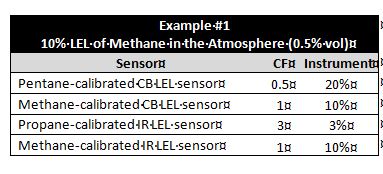 In this basic example, both CB and IR sensors, when calibrated with methane, are very accurate in their detection of methane, as expected. A pentane-calibrated catalytic bead LEL sensor will read high because the correlation factor is 0.5. On the other hand, a propane-calibrated infrared LEL sensor will read low at 3 percent LEL.
In this basic example, both CB and IR sensors, when calibrated with methane, are very accurate in their detection of methane, as expected. A pentane-calibrated catalytic bead LEL sensor will read high because the correlation factor is 0.5. On the other hand, a propane-calibrated infrared LEL sensor will read low at 3 percent LEL.
This example highlights the importance of two best practices: 1) Calibrating to the known hazard in the atmosphere will lead to the most accurate results. If methane is the known hazard, calibrate your LEL sensor to methane. It doesn’t matter if you are using a CB or IR sensor. Correlation factors are never perfect and will introduce error into your readings, so calibrating to the known hazard leads to the most accurate results. 2) Catalytic bead LEL sensors calibrated to pentane typically have correlation factors of less than two and often close to one. For that reason, many gas detection manufacturers recommend pentane calibration for CB sensors because the instrument will reduce the error between the real gas concentration and the instrument reading.
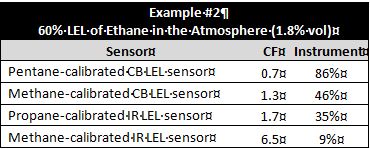 The second example shows a potentially dangerous scenario in the field. Some gas detection manufacturers recommend methane-calibration for their IR LEL sensors. Even with 60 percent LEL ethane in the atmosphere, a methane-calibrated IR LEL sensor will display only 9 percent LEL.
The second example shows a potentially dangerous scenario in the field. Some gas detection manufacturers recommend methane-calibration for their IR LEL sensors. Even with 60 percent LEL ethane in the atmosphere, a methane-calibrated IR LEL sensor will display only 9 percent LEL.
This example highlights a third best practice. It is that setting low alarm levels are very important for safety. Many industry leaders recommend a 10 percent LEL low alarm and 20 percent LEL high alarm levels. In the example above, a methane-calibrated infrared sensor will trigger a 10 percent LEL low alarm only with 65 percent LEL ethane in the atmosphere. Although the instrument will alarm late, the atmosphere is not yet combustible.
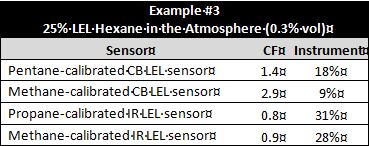 In Example #3, a methane-calibrated CB LEL sensor is now the culprit in alarming late. All three of the other sensors are in alarm, with the infrared sensors in high alarm. Example #2 showed the infrared sensors alarming slowly, while Example #3 shows that catalytic bead sensors also have this limitation at times.
In Example #3, a methane-calibrated CB LEL sensor is now the culprit in alarming late. All three of the other sensors are in alarm, with the infrared sensors in high alarm. Example #2 showed the infrared sensors alarming slowly, while Example #3 shows that catalytic bead sensors also have this limitation at times.
Acetylene is a common welding gas. When using acetylene, it is very important to understand which type of LEL sensor to use. Some IR LEL sensors will not detect several combustible gases, including (but not limited to) acetylene, hydrogen, and carbon disulfide. In this scenario, the infrared sensor will not respond at all, regardless of concentration. The calibration gas also will not impact the result, as the sensor simply will not detect acetylene. Check with your gas detection manufacturer for details.
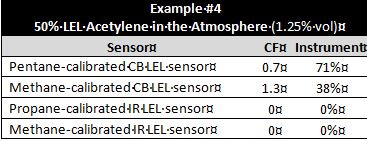 CB LEL sensors detect combustible gas by burning it. With low levels of oxygen, combustion is incomplete or impossible. In atmospheres with less than 10 percent oxygen, users should not trust the LEL readings on their instruments because the sensor does not have adequate oxygen to properly detect the hazard. Dilution tubes or IR sensors should be considered when oxygen levels are less than 10 percent volume. Again, ask your manufacturer for details since each CB sensor responds differently to low levels of oxygen.
CB LEL sensors detect combustible gas by burning it. With low levels of oxygen, combustion is incomplete or impossible. In atmospheres with less than 10 percent oxygen, users should not trust the LEL readings on their instruments because the sensor does not have adequate oxygen to properly detect the hazard. Dilution tubes or IR sensors should be considered when oxygen levels are less than 10 percent volume. Again, ask your manufacturer for details since each CB sensor responds differently to low levels of oxygen.
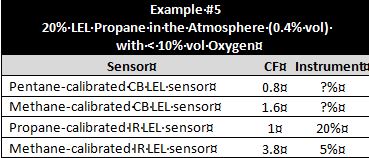 Also, in Example #5, the methane-calibrated infrared LEL sensor does not alarm due to the 3.8 correlation factor. This situation was also found in Example #2. The atmosphere actually must reach 38 percent LEL before reaching a 10 percent LEL low alarm. Again, this highlights the fact that users must understand that IR correlation factors are often dramatically different than CB correlation factors.
Also, in Example #5, the methane-calibrated infrared LEL sensor does not alarm due to the 3.8 correlation factor. This situation was also found in Example #2. The atmosphere actually must reach 38 percent LEL before reaching a 10 percent LEL low alarm. Again, this highlights the fact that users must understand that IR correlation factors are often dramatically different than CB correlation factors.
Two other considerations should be made when comparing CB LEL to IR LEL sensors: 1) CB LEL sensors may be inhibited or poisoned by various chemicals, including silicone. When these sensors are exposed to silicone, their reaction to combustible gases is reduced or eliminated. Many everyday items (like Armor All®) are proven to damage CB LEL sensors. IR LEL sensors are not poisoned by these chemicals. 2) Correlation factors for CB LEL sensors may change over time as the sensor ages. This is particularly important for methane detection when calibrating with a gas other than methane. Periodic exposure of a known concentration of methane gas to pentane-calibrated sensors is recommended to validate performance.
In conclusion, I hope the previous examples clearly identified the risk of not understanding the complexity of gas detection and reinforced the importance of selecting the right correlation factor, calibration gas, and LEL sensor for your application. Your team's safety depends on it.
This article originally appeared in the May 2014 issue of Occupational Health & Safety.